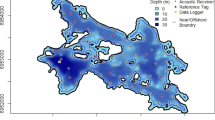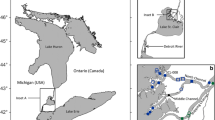Abstract
Adult roach (Rutilus rutilus) (13–25 cm) from two shallow lakes, one turbid and one with high water transparency, were tagged with surgically implanted miniature radio transmitters and their habitat use was monitored. Repeated tracking series over the course of the year provided information on seasonal changes in behaviour of roach in the two lakes. The results showed that the roach generally used the lakes only as summer habitat, whereas they moved into specific sheltered, restricted areas during winter. This behaviour was most pronounced in the lake with clear water, where roach gathered in large numbers in the stream in- and outlets as well as in other sheltered habitats where they remained rather passively during the 48 h tracking periods. In the turbid lake, many of the tagged roach, were even found in underground channels during the tracking in November. We see this behaviour as a response to low food abundance, decreased food demand and high predation risk, especially from birds. The tracking data from the clear lake showed that some tagged roach undertook swift habitat shifts from one refuge to the other. The traditional perception of the roach as a `lake fish' with an important structuring role in the lake ecosystem is undoubtedly true, but the present results suggest that roach are able to migrate between different habitat types and will do so if they can profit from this behaviour.
Similar content being viewed by others
References
Baade, U. & F. Fredrich, 1998. Movement and pattern of activity of the roach in the River Spree, Germany. J. Fish Biol. 52: 1165-1174.
Bean, C. W. & I. J. Winfield, 1995. Habitat use and activity patterns of roach (Rutilus rutilus (L.)), rudd (Scardinius erythrophthalmus (L.)), perch (Perca fluviatilis (L.)) and pike (Esox lucius (L.)) in the laboratory: the role of predation threat and structural complexity. Ecol. Freshwat. Fish 4: 37-46.
Berg, S., E. Jeppesen & M. Søndergaard, 1997. Pike (Esox lucius L.) stocking as a biomanipulation tool. 1. Effects on the fish population in Lake Lyng, Denmark. Hydrobiologia 342/343: 311-318.
Bouvet, Y., E. Pattee & F. Meggouh, 1984. The contribution of backwaters to the ecology of fish populations in large rivers. Preliminary results on fish migrations within a side arm from the side arm to the main channel of the Rhone. Verh. int. Ver. Theo. Ang. Limn. 22: 2576-2580.
Brabrand, Å & B. Faafeng, 1993. Habitat shift in roach (Rutilus rutilus) induced by pikeperch (Stizostedion lucioperca) introduction: predation risk versus pelagic behaviour. Oecologia 95: 38-46.
Christoffersen, K. & S. Bosselmann, 1997. Zooplankton: growth, grazing and interactions with fish. In Sand-Jensen, K. & O. Pedersen (eds), Freshwater Biology, Priorities and Developement in Danish Research. C. E. C. Gad, Copenhagen: 254 pp.
Cryer, M., G. Peirson & C. R. Townsend, 1986. Reciprocal interactions between roach, Rutilus rutilus, and zooplankton in a small lake: Prey dynamics and fish growth and recruitment. Limnol. Oceanogr. 31: 1022-1038.
Eklöv, P. & L. Persson, 1995. Species-specific antipredator capacities and prey refuges: interactions between piscivorous perch and juvenile roach. Behav. Ecol. Sociobiol. 37: 169-178.
Horppila, J. & T. Kairesalo, 1990. A fading recovery: the role of roach (Rutilus rutilus L.) in maintaining high phytoplankton productivity and biomass in Lake Vesijärvi, southern Finland. Hydrobiologia 200/201: 153-165.
Jacobsen, L.& S. Berg, 1998. Diel variation in habitat use by planktivores in field enclosure experiments: the effect of submerged macrophytes and predation. J. Fish Biol. 53: 1207-1219.
Jacobsen, L., M. R. Perrow, F. Landkildehus, M. Hjørne, T. L. Lauridsen & S. Berg, 1997. Interactions between piscivores, zooplanktivores and zooplankton in submerged macrophytes: preliminary observations from enclosure and pond experiments. Hydrobiologia 342/343: 197-205.
Jepsen, N., K. Aarestrup, F. Økland & G. Rasmussen, 1998. Survival of radiotagged Atlantic salmon (Salmo salar L.)-and trout (Salmo trutta L.) smolts passing a reservoir during seaward migration. Hydrobiologia 371/372: 347-353.
Jepsen, N., L. E. Davis, C. B. Schreck & B. Siddens, 2001. The physiological response of chinook salmon smolts to two methods of radio-tagging. Trans. am. Fish. Soc. 130: 495-500.
Jeppesen E., J. P. Jensen, P. Kristensen, M. Søndergaard, E. Mortensen, O. Sortkjær & K. Olrik, 1990. Fish manipulation as a lake restoration tool in shallow, eutrophic, temperate lakes 2: threshold levels, long-term stability and conclusions. Hydrobiologia 200/201: 219-227.
Jeppesen, E., J. P. Jensen, M. Søndergaard & T. Lauridsen, 1999. Trophic dynamics in turbid and clearwater lakes with special emphasis on the role of zooplankton for water clarity. Hydrobiologia 408/409: 217-231.
Krause, J., G. Staaks & T. Mehner, 1998. Habitat choice in shoals of roach as a function of water temperatures and feeding rate. J. Fish Biol. 53: 377-386.
Persson, L., S. Diehl, L. Johansson, G. Andersson & S. F. Hamrin, 1991. Shifts in fish communities along the productivity gradient of temperate lakes-patterns and the importance of size-structure. J. Fish Biol. 38: 281-293.
Savino, J. F. & R. A. Stein, 1989. Behaviour of fish predators and their prey: habitat choice between open water and dense vegetation. Envir. Biol. Fishes 24: 287-293.
Smith, R. J. F., 1991. Social behaviour, homing and migration. In Winfield, I. J. & J. S. Nelson (eds), Cyprinid Fishes, Systematics, Biology and Exploitation. Chapman & Hall, London: 509-529.
Skårup, S. & P. H. Møller, 1996. Lake Torup, Lake Halle & Lake Stigsholm, environmental conditions 1975-1995. County of Vejle: 149 pp. (in Danish).
Vøllestad, L. A. & J. H. LAbée-Lund, 1987. Reproductive biology of stream-spawning roach, Rutilus rutilus. Environ. Biol. Fishes 18: 219-227.
Werner, E. E., J. F. Gilliam, D. J. Hall & G. G. Mittelbach, 1983. An experimental test of the effects of predation risk on habitat use in fish. Ecology 64: 1540-1548.
Author information
Authors and Affiliations
Rights and permissions
About this article
Cite this article
Jepsen, N., Berg, S. The use of winter refuges by roach tagged with miniature radio transmitters. Hydrobiologia 483, 167–173 (2002). https://doi.org/10.1023/A:1021379528719
Issue Date:
DOI: https://doi.org/10.1023/A:1021379528719




